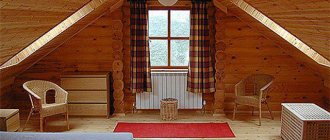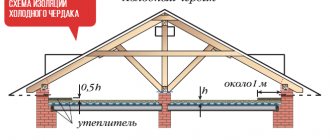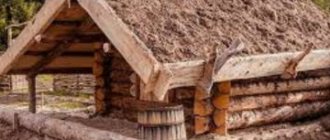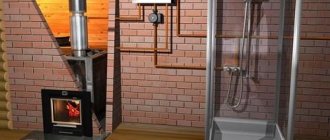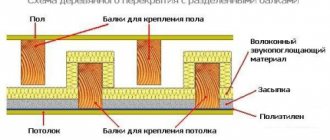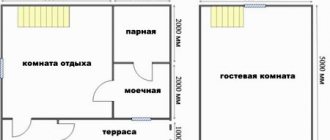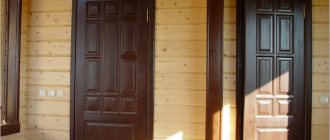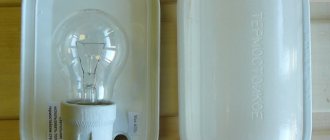When going to a hot bathhouse to take a steam bath, we certainly put on a warm hat, although for a beginner it looks more than strange. But a hat is like a heat insulator that absorbs moisture and protects your head from overheating. Likewise, when building the bathhouse itself, the insulated ceiling is the most important part.
It is unacceptable to forget about this after insulating the floor and walls, for which different materials are used. In order for the bathhouse to retain heat well, it is necessary to correctly select the insulating material and method of thermal insulation of the ceiling, of course, taking into account the type of roof.
Main types of attic roofs
- Cold - for their installation, a sheathing is stuffed onto the rafters, taking into account the roofing covering, roofing material is attached to it, insulation is carried out along the ceiling, laying thermal insulation on it, which is covered with a vapor barrier on the room side, and a waterproofing membrane on the attic side;
- insulated - for exploited under-roof spaces - attics, additional elements are added to the previous components: insulation, vapor barrier, waterproofing, counter-lattice - timber with a section of 40 x 40, 50 x 50, 60 x 60 mm, placed on the rafters along their length. A waterproofing material is laid on the beam, protecting the insulation and roof from external moisture, then the sheathing is laid on which the roofing covering is attached. The spaces between the rafters are filled with appropriate insulation, and from the attic side it is covered with a vapor barrier layer.
Types of bathhouse ceiling insulation:
- outside - more convenient to use, most effective for a ceiling located under an uninsulated roof, the insulation is laid out on the attic floor and covered with a rough or finished floor;
- from the inside – it prolongs the durability of the material, there are no temperature changes, but you will have to “steal” a few centimeters of the height of the bathhouse, a frame is mounted on the ceiling, after fixing the first layer of vapor barrier, and insulation is placed in it, then the vapor barrier is again and the ceiling covering is attached.
Traditional methods of insulating a bathhouse ceiling
Baths have existed since ancient times. Our ancestors knew for sure how to insulate a bathhouse from the inside. They used improvised materials, which cost very little in our time, and at the same time they are environmentally friendly. Of course, compared to modern materials, installing insulation using traditional methods requires more labor.
Sawdust and clay
To insulate the ceiling of a bathhouse that has an attic compartment, you can use materials such as sawdust, clay and sand. The insulation process is arranged in the following order:
Make sure that the sawdust is dry. Therefore, it is better to take them from a carpentry shop, since they use wood with a low moisture content. In the old days, about 3 cm of ash was poured on top of the sawdust layer.
Expanded clay
To insulate a steam room or sauna, it is better to use expanded clay. This type of material has high thermal insulation properties, but has a significant drawback. Expanded clay absorbs moisture very easily. Therefore, using expanded clay, you should provide a very high-quality vapor barrier on the side of the room. A layer of expanded clay up to 30 cm thick is poured on top of it, and then waterproofing is provided.
Here you can also use earth, or you can use modern materials. If you plan to use the attic, you should install a flooring made of boards to reduce the area of pressure on the ceiling when walking.
With a cold roof or with an attic - what's the difference?
If there is an attic floor, there is a problem with the penetrating temperature threshold from the steam room, from where a large amount of steam, warm and hot air rises and, accordingly, if it is not properly disposed of, it will accumulate in the attic space. Therefore, in order to insulate the ceiling in a bathhouse with a cold roof, you should carefully calculate the thickness of the ceiling insulation taking into account the loads and take care of better vapor and waterproofing.
There is an opinion that it is not necessary to insulate the ceiling in a bathhouse with an attic, but increasing the thermal insulation characteristics in it is more necessary than in an uninsulated attic space, where the heat penetrating outside does not encounter serious obstacles on its way.
Insulation of the ceiling in a bathhouse with a cold roof
Warm air is lighter than cold air, so it rushes upward.
Without meeting a barrier, it will heat the atmosphere; in order not to take part in the progress of global warming, it is necessary to organize proper thermal insulation. Air masses filling the under-roof space, of course, retain heat leakage, but this is not enough. With properly carried out thermal insulation measures, the time for heating the room is significantly reduced, fuel is saved, heat and steam are saved longer, and the service life of the ceiling increases . Installing insulation in a multi-layer roof system prevents many types of heat loss.
How to insulate
Before laying the thermal insulation layer, a vapor barrier is laid. It prevents the transit of wet vapors and their settling in the insulation layer, because Water accumulated in the thermal insulation will increase the weight of the ceiling system and deteriorate the insulating qualities.
The following are used as a vapor barrier layer: aluminum foil, compacted cardboard impregnated with drying oil, wax paper, special film with lint, membrane material.
For more information on using foil, see this page
How to insulate
Ceiling insulation with sawdust
Traditionally, people insulated wooden houses with sawdust and lived without bothering in warm houses in severe frosts. People still recommend insulating the ceiling with dry straw and fragrant sawdust to this day. They are environmentally friendly, safe, hypoallergenic, natural. No special skills or special tools are required to use them.
If there is a solid base, a vapor barrier is first laid: roofing felt, rubimast, high-strength cardboard or membrane film; the edges are brought out to the sides of the beams and attached with a stapler to prevent spillage downwards. The cracks are first filled with foam. Then sawdust is poured in, pure or with impurities.
Sawdust-based insulation compositions
Sawdust-based insulation compositions are:
- clean - sawdust of different fractions is used, a rough layer - coarse shavings - 10 cm, finishing - another 10 cm of fine shavings, usually this thickness coincides with the height of the beams, a diffuse membrane is spread on top so that the sawdust does not fly apart;
- with clay - first option : lay out a layer of crumpled clay - 20-25 mm, on top of sawdust as a thermal insulation layer - 10-15 cm, dry earth - 10-15 cm;
- second : shavings are mixed with clay in equal volumes and laid out on a prepared base 10 cm thick; clay to sawdust ratio 2:3;
- with cement - sawdust is mixed with cement in a ratio of 10:1, mixed with water to a very thick solution, laid in a layer 20-30 cm thick, antiseptic and fire retardants are added if desired.
Clay-based solutions
Clay concrete is obtained by mixing: sawdust, clay, lime, cement or gypsum with water. To knead 1 cube you will need: 200 kg of sawdust, 300 kg of cement, 70 kg of lime, 300 kg of clay, 350 liters of water. First of all, combine the dry ingredients, then add lime and clay. The result is a solution with good thermal insulation qualities, durable, reliable, inexpensive, and does not rot.
Clay-sand - the ratio of sand and clay is 2:6, water is added to the consistency of sour cream. The cracks of the flooring are covered with liquid clay, after drying, a vapor barrier membrane is laid with an overlap of 15-20 cm, the joints are glued with foil tape, the base is evenly covered with a mixture of sand and clay with a thickness of 5-7 cm, after hardening, we fill it with 10-15 cm of dry sand, logs can be mounted on top and finishing floor.
Expanded clay
Bulk type thermal insulation material. An environmentally friendly product, made from clay, perfect for thermal insulation of a bathhouse ceiling. Main properties: non-flammable, does not emit harmful substances when heated, light weight, does not create additional load. To insulate the ceiling, expanded clay with a fraction size of 4-10 mm is used, the layer thickness is at least 30 cm.
Useful video
Watch a video about how to properly use expanded clay for ceiling insulation and what mistakes to avoid:
Minvata
Mineral-based fibrous insulation is produced in the form of mats, slabs, and rolls. It is considered the most effective for thermal insulation of ceilings, it has a long service life, although it also costs more. Properties of mineral wool: retains heat well, noise insulator. Placed between floor joists. For a bathhouse with an insulated attic, a thickness of 10 cm is sufficient, with a cold ceiling of 15-20 cm.
Other insulation materials
• ecowool made from small cellulose fibers; • polystyrene foam boards are a favorite among heat-insulating building materials due to their ease of installation and low cost; • folgoizol is used to preserve the heat of the ceilings of baths and saunas; it is not subject to corrosion and decay from the environment. • polyurethane foam – a material sprayed using special equipment.
Insulation for bathhouse ceilings: which one to choose from a wide range
As already mentioned, it is impossible to unequivocally answer the question “which insulation is best for a bathhouse ceiling,” because the choice of the type of insulation primarily depends on the design of the ceiling in your bathhouse. Mandatory requirements for thermal insulation materials include compliance with environmental friendliness and safety parameters.
The bathhouse has a special temperature regime during its operation, therefore all insulation materials:
- must be resistant to high temperatures (including temperature changes);
- must be fireproof;
- should not emit toxic and harmful substances when heated;
- be resistant to mold, mildew, etc.
Ecowool
Ecowool, as thermal insulation for a bathhouse ceiling, is a type of environmentally friendly insulation, due to the presence of cellulose in its composition. Boric acid, which is part of it, ensures the material’s resistance to rot and insect damage. In addition, it is fireproof, because Fire retardants are used in its production. The disadvantages include the difficulty of applying the “wet” method, which is considered the most effective (fills all cavities and crevices), because requires specialized equipment.
Useful video
The following video shows how easy it is to insulate with ecowool yourself:
Mineral wool
It is considered a classic option, providing high heat retention performance. The downside is that the insulating properties are lost when the cotton gets wet.
REFERENCE. We recommend laying a layer of waterproofing to protect the mineral wool. In addition, we recommend limiting the use of mineral wool in the part of the ceiling above the steam room.
ATTENTION! Formaldehyde and other resins may be released.
Foil
A bathhouse insulated with foil heats up faster and cools down more slowly. The foil additionally serves as a vapor barrier, because does not allow steam and moisture to pass through, can withstand high temperatures and does not emit substances harmful to humans. The disadvantages include difficulties in installation: jams and breaks should not be allowed. The foil must be overlapped and the seams taped with aluminum tape.
Foil insulation
The ease of foil to tear influenced the appearance of foil materials on a substrate of paper, fabric and other heat-insulating materials. The advantages include the low weight of such insulation, good insulating and reflective properties. Like foil, they can act as a vapor barrier.
The downside is the installation method: even specialized glue does not always cope with its task. It is not advisable to use nails, staplers and other fasteners that pierce through - the insulating properties of the insulation are lost.
Expanded clay
It has good heat-insulating properties, is relatively inexpensive, easy to install, environmentally friendly, does not wrinkle and retains its properties, and is not affected by low temperatures.
The disadvantages include a high ability to absorb water, which can become a problem if there is no vapor barrier on the side of the premises. In addition, as water is absorbed, the weight of expanded clay also increases. Therefore, it is necessary to carefully consider the design of the foundation of the bathhouse and its structures.
Useful video
Watch a video about how to properly use expanded clay for ceiling insulation and what mistakes to avoid:
Vermiculite
It has high fire resistance, does not attract rodents and insects, and is biologically stable. Easy to install (high flowability ensures filling of the entire space), not subject to shrinkage or temporary changes. There is no use of harmful substances or materials in its production. Hypoallergenic.
Minus - requires hydro- and vapor protection to ensure ventilation. Unfortunately, it has a high cost.
Folk materials for insulating bathhouse ceilings
Traditional and time-tested insulation materials include such materials as: clay, sawdust, earth, slag and their combinations. An undoubted advantage is their availability, price (low cost, or the ability to get it for free).
The disadvantages include the labor-intensive process of use: sawdust requires an additional layer of earth (to ensure fire safety), and over time it shrinks. In addition, such materials for insulating the bathhouse ceiling can crumble through the ceiling, forming permanent dirt.
Useful video
Watch a video about how the above-mentioned shortcomings can be eliminated by adding a little cement to the sawdust:
Insulation of the ceiling in a bathhouse with an attic
The attic room is the coldest in the bathhouse, because...
does not have a “thermal cushion”, so insulating the ceiling in a bathhouse with an attic is the most important task; with such a structural design, thermal insulation is used for both the second floor floor and the roof. After all, the excess heat from the bathhouse fully heats the attic room, and the heat-insulating layer prevents it from overheating. Conserving heat under the roofing material is also necessary. Both in winter and summer, you will be comfortable. Under the summer sun, the roof heats up, the outside heat combines with that coming from the steam room, and as a result, on a bath day you will get a scorching heat on the second floor.
How to insulate
The approximate “pie” of insulation from the inside of a steam room (about insulation for a steam room here) is as follows:
- lining;
- rail;
- foil taped with tape;
- rough board 150 x 20 mm;
- floor beam;
- glassine;
- expanded clay – 120 mm;
- Rockwool insulation – 50 mm;
- glassine;
- batten.
Useful video
Look at the explanation of the above illustration of a bathhouse roof pie with an attic:
Read more about mansard roofs for baths here.
How to insulate
What thermal insulation material should I use? Yes, everything that is listed above, from time-tested, natural, natural insulation materials to ultra-modern ones (wood chips, shavings, sawdust, sand, expanded clay, mineral wool, basalt wool, ecowool). More information on insulation for baths here.
conclusions
Heat leakage problems need to be solved comprehensively, and not just those discussed in this article. There are no trifles in organizing thermal insulation; window and door openings, walls, roof, ceiling, floor - everything must be done correctly, in compliance with building codes and calculations taking into account your region. When insulating the ceiling in a bathhouse with an attic, you should also take into account the thermal insulation features of buildings made of different materials: foam block, brick, frame, timber or logs.
Glass wool
This is the same mineral wool. As a candidate for ceiling insulation in a bathhouse, it has the same excellent characteristics as basalt wool. But there is one significant “but”.
Glass wool fibers are extremely brittle and can crumble into microscopic filaments that can even penetrate under a person's clothing and cause severe itching.
What can we say about a bathhouse where a person is without clothes at all?
Conclusion: if there is anything to cover the ceiling in a bathhouse with, it’s not glass wool.
We examined all lightweight types of insulation and determined that only basalt mineral wool is suitable for a suspended ceiling in a bathhouse.
